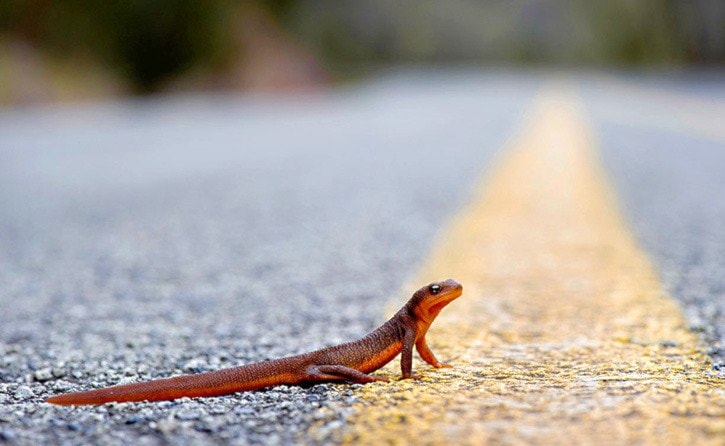Near the end of the pond in a sheltered pocket of water dozens of rough-skinned newts energetically swim along, their soft-orange bellies standing out against the murk.
Biologist Kristiina Ovaska surveys the East Sooke lakeshore and points out the rushes and vegetation.
“This would be a great habitat for newts, females lay their eggs one at a time on plants like these,” she says.
The Habitat Acquisition Trust is on a mission to save the newts and their amphibian cousin, the frog. Ovaska, an expert on amphibians, is leading the charge.
“Amphibians are so important to our ecosystem,” says Ovaska. “They can be used as indicators of healthy environments and healthy wetlands.”
The Habitat Acquisition Trust is gathering as much information as it can on frogs and salamanders in the region to ward off possible declines.
Frogs and salamanders face many hurdles to survival.
A new deadly fungal disease has killed salamanders in Europe in alarming numbers, and more data are needed before it arrives in North America. A similar chytrid disease resulted in declines and losses of frog populations worldwide.
Another problem? Road kill.
In early spring, many amphibians make their way to sheltered slow moving waters to find a mate.
The journey turns perilous when the tiny amphibians try to cross the road from forests to reach breeding ponds on the other side in landscapes fragmented by busy roads.
“Our objective is to identify these hot spots and where the animals are getting killed, so something can be done about it,” Ovaska says.
Ovaska recalled last spring in East Sooke where a roadway was covered with newts. A nearby resident was re-directing traffic around the amphibians, but by the time the Habitat Acquisition Trust arrived the migration was finished.
In an effort to find existing salamander and newt habitat, the Habitat Acquisition Trust is looking for reports of amphibian breeding ponds within the Greater Victoria region.
On rainy nights, Habitat Acquisition Trust volunteers are spending their evenings surveying roads that have previously documented the highest death tolls of frogs and salamanders due to vehicle traffic.
Sometimes volunteers are lucky enough to assist a frog or salamander to make its way safely across. On a single stretch of road, after one night survey, the record of squashed amphibians can reach into the hundreds.
The Habitat Acquisition Trust is using the data gathered during these road-crossings to identify hotspots of amphibian road kill. The land trust needs to know where the problem spots are to take further action and improve road safety for amphibians. For example, small fences can redirect amphibians to culverts, and “toad tunnels” can be created in appropriate spots.
Habitat Acquisition Trust is also partnering with Caren Helbing of the University of Victoria, and the Canadian Wildlife Health cooperative to store tissue samples of road-killed amphibians for DNA testing.
This will help identify the current health status of newts on southern Vancouver Island and provide early detection for emerging amphibian diseases to curb their spread.
“Programs such as this are essential for promoting stewardship activities and protecting natural areas and species whose distributions within populated areas overlap extensively with private lands,” explains Helbing.
For more information on the Habitat Acquisition Trust, please call 250-995-2428 or email hatmail@hat.bc.ca.
